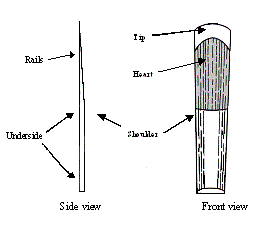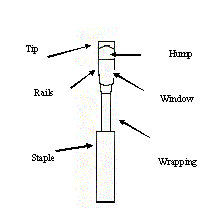Introduction
Single Reeds
Double Reeds
Woodwind players spend much more time fussing over reeds than brass players do over alternate mouthpiece designs. The reasoning is simple enough. Whereas brass instrument mouthpieces merely assist in the vibration of the lips, tone generation on most woodwind instruments depends on proper reed vibration. The quality of the reed is therefore of great importance. Moreover, since no reed lasts more than a few weeks, woodwind players are constantly on the lookout for fresh ones. At least they should be! As the reed begins to
deteriorate, the player attempts to adjust his embouchure to compensate. While this can work up to a point, continued use of a weakened reed will inevitably damage the embouchure and encourage the player to accept a poorer tone quality.
Mouthpieces are still important to woodwind players, of course. Interestingly enough, some reeds can work perfectly well on some mouthpieces and not at all on others.
Both double and single reed instruments make use of flexible slivers of carefully crafted cane. As in the case of brass instrument mouthpieces, there is no such thing as a perfect reed for all players or all instruments. Reeds that are too stiff tend to cause the instrument to go sharp and may produce a hard, strident sound. They can also be difficult to control, especially for a beginner. This is often true of reeds that have yet to be broken in. Even so, regular use of stiffer reeds produces a better embouchure and a more satisfying tone.
Old or poor quality reeds should not be thrown away. Instead, students should be encouraged to inspect them closely for workmanship and even take them apart. They may also experiment by clipping or filing them in various ways to discover how this changes the reed’s pitch and tonal response.
On single reed instruments such as the clarinet and the saxophone, the reed is attached to the mouthpiece by a clamping device called a ligature. This is designed to hold the reed firmly in position while still allowing it to vibrate freely. The tip of the mouthpiece curves slightly away from the reed, leaving a small opening for the air to move through. The positioning of the ligature is important: too high and the tone will sound stuffy; too low and the tone becomes harsh. Since the reed itself has a resonant frequency, great care must be taken to ensure that when the air is blown through the instrument the resulting sound is determined by the fingering set by the player rather than the reed.
There are, of course, other reasons why unwelcome squeaks can occur. A warped or badly positioned reed, for example, could be responsible. The increased compression produced by many jazz and rock saxophone mouthpieces can also produce squeaks, particularly when used with thin-tipped French reeds.
Clarinet and saxophone reeds are cut from tubes that are thicker in the center than on the sides. There is therefore a danger that moisture will cause the reed to warp as it swells. This swelling, which particularly acute in a new reed, can damage both the tone and the response of the instrument. If warpage does occur, it is possible to flatten the underside by using a wood file. However, since this risks thinning the reed (and thus producing a harsher sound) it is best avoided unless absolutely necessary.
The following illustration shows the main sections of a single reed:

The “heart” is the thicker central portion of the reed. Its function is to provide resistance when blowing. If it is too thick, the instrument becomes unresponsive and the pitch tends to be sharp. If it is too thin, on the other hand, the tone loses its richness and the pitch tends to be flat.
Many jazz players prefer the “American” style reed. This has a thicker tip and a flatter heart than the more standard varieties. Such players are sacrificing some cleanness at the start of the note in return for greater stability and a more aggressive tone color, particularly in the lower register.
Many advanced players like to shape their own reeds to suit their particular preferences. It is important, however, to delay making any such adjustments until the reed is sufficiently broken in and has assumed its regular shape. A useful chart on single reed adjustment can be found in Larry Teal's The Art of Saxophone Playing (Sammy-Birchard Publishing, Evanston, 1963, page 29).
While it is almost impossible to tell the quality of a reed merely by looking it, the following widely accepted characteristics of a good reed may prove useful:
|
|
|
|
|
|
|
|
|
|
|
A double reed consists of two blades of cane bound together. Whereas the area within the mouthpiece of a single reed instrument acts as the vibrating chamber, in the case of the oboe and the bassoon the vibrating chamber is the tiny area between the two reeds. This design gives the performer greater control over pitch, volume level and tone color than a single reed player.
The following illustration shows the main sections of a double reed:

The “blend” is that section of the reed that connects the tip with the hump. Its shape has an important influence on the sound. A sharply defined blend produces a more stable pitch but the sound is generally weaker than a blend with a more elongated shape. Most players go for a compromise.
The “hump” or heart of the reed is the raised portion between the tip and the window. As in the case of single reeds, its function is to provide resistance. This hump should taper smoothly towards the tip. Optional cutout portions at the back of the reed are called “windows”. Some players use them as a means of improving the tone and response of the instrument. However, windows should probably not be introduced until reed already plays well without them.
The “staple” is the corked tube that is attached to the reed. On bassoons, a metal tube called a “bocal” has a similar function. There is no real consensus about the significance of either the length of the staple or the material it is made of. Some oboists argue, for example, that a longer tube produces a more stable and penetrating sound quality while others say that there is no difference.
While performance rather than looks should be the deciding factor in selecting a good double reed, the following characteristics should assist those unable to play one before purchasing it:
|
|
|
|
|
|
|
|
|
|
|
It is also a good idea to “crow” on a double reed before inserting it into the oboe or bassoon. This sound is created by placing the reed much further into the mouth than would be required in normal playing. The student blows through the reed until a loud “crowing” or siren is heard. This sound is an indication that the reed is vibrating properly and is in good working condition.












